Related Research Articles
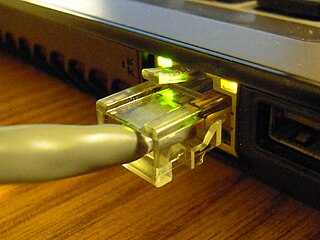
Ethernet is a family of wired computer networking technologies commonly used in local area networks (LAN), metropolitan area networks (MAN) and wide area networks (WAN). It was commercially introduced in 1980 and first standardized in 1983 as IEEE 802.3. Ethernet has since been refined to support higher bit rates, a greater number of nodes, and longer link distances, but retains much backward compatibility. Over time, Ethernet has largely replaced competing wired LAN technologies such as Token Ring, FDDI and ARCNET.
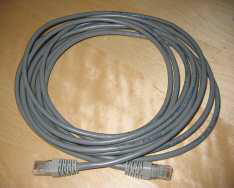
Ethernet over twisted-pair technologies use twisted-pair cables for the physical layer of an Ethernet computer network. They are a subset of all Ethernet physical layers.
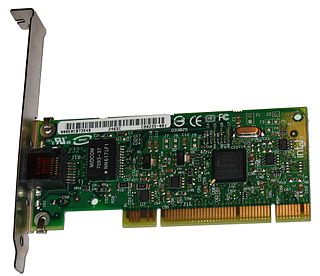
In computer networking, Gigabit Ethernet is the term applied to transmitting Ethernet frames at a rate of a gigabit per second. The most popular variant, 1000BASE-T, is defined by the IEEE 802.3ab standard. It came into use in 1999, and has replaced Fast Ethernet in wired local networks due to its considerable speed improvement over Fast Ethernet, as well as its use of cables and equipment that are widely available, economical, and similar to previous standards. The first standard for faster 10 Gigabit Ethernet was approved in 2002.
In the seven-layer OSI model of computer networking, the physical layer or layer 1 is the first and lowest layer: the layer most closely associated with the physical connection between devices. The physical layer provides an electrical, mechanical, and procedural interface to the transmission medium. The shapes and properties of the electrical connectors, the frequencies to transmit on, the line code to use and similar low-level parameters, are specified by the physical layer.

A virtual local area network (VLAN) is any broadcast domain that is partitioned and isolated in a computer network at the data link layer. In this context, virtual refers to a physical object recreated and altered by additional logic, within the local area network. Basically, a VLAN behaves like a virtual switch or network link that can share the same physical structure with other VLANs while staying logically separate from them. Between network devices, VLANs work by applying tags to network frames and handling these tags in networking systems –creating the appearance and functionality of network traffic that is physically on a single network but acts as if it were split between separate networks. In this way, VLANs can keep network applications separate despite being connected to the same physical network, and without requiring multiple sets of cabling and networking devices to be deployed.
EtherType is a two-octet field in an Ethernet frame. It is used to indicate which protocol is encapsulated in the payload of the frame and is used at the receiving end by the data link layer to determine how the payload is processed. The same field is also used to indicate the size of some Ethernet frames.

Power over Ethernet (PoE) describes any of several standards or ad hoc systems that pass electric power along with data on twisted-pair Ethernet cabling. This allows a single cable to provide both a data connection and enough electricity to power networked devices such as wireless access points (WAPs), IP cameras and VoIP phones.
A fieldbus is a member of a family of industrial digital communication networks used for real-time distributed control. Fieldbus profiles are standardized by the International Electrotechnical Commission (IEC) as IEC 61784/61158.
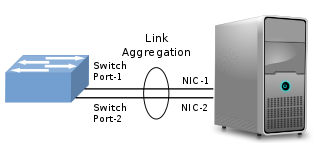
In computer networking, link aggregation is the combining of multiple network connections in parallel by any of several methods. Link aggregation increases total throughput beyond what a single connection could sustain, and provides redundancy where all but one of the physical links may fail without losing connectivity. A link aggregation group (LAG) is the combined collection of physical ports.

Profinet is an industry technical standard for data communication over Industrial Ethernet, designed for collecting data from, and controlling equipment in industrial systems, with a particular strength in delivering data under tight time constraints. The standard is maintained and supported by Profibus and Profinet International, an umbrella organization headquartered in Karlsruhe, Germany.
Avionics Full-Duplex Switched Ethernet (AFDX), also ARINC 664, is a data network, patented by international aircraft manufacturer Airbus, for safety-critical applications that utilizes dedicated bandwidth while providing deterministic quality of service (QoS). AFDX is a worldwide registered trademark by Airbus. The AFDX data network is based on Ethernet technology using commercial off-the-shelf (COTS) components. The AFDX data network is a specific implementation of ARINC Specification 664 Part 7, a profiled version of an IEEE 802.3 network per parts 1 & 2, which defines how commercial off-the-shelf networking components will be used for future generation Aircraft Data Networks (ADN). The six primary aspects of an AFDX data network include full duplex, redundancy, determinism, high speed performance, switched and profiled network.
EtherCAT is an Ethernet-based fieldbus system developed by Beckhoff Automation. The protocol is standardized in IEC 61158 and is suitable for both hard and soft real-time computing requirements in automation technology.

The physical-layer specifications of the Ethernet family of computer network standards are published by the Institute of Electrical and Electronics Engineers (IEEE), which defines the electrical or optical properties and the transfer speed of the physical connection between a device and the network or between network devices. It is complemented by the MAC layer and the logical link layer. An implementation of a specific physical layer is commonly referred to as PHY.
40 Gigabit Ethernet (40GbE) and 100 Gigabit Ethernet (100GbE) are groups of computer networking technologies for transmitting Ethernet frames at rates of 40 and 100 gigabits per second (Gbit/s), respectively. These technologies offer significantly higher speeds than 10 Gigabit Ethernet. The technology was first defined by the IEEE 802.3ba-2010 standard and later by the 802.3bg-2011, 802.3bj-2014, 802.3bm-2015, and 802.3cd-2018 standards. The first succeeding Terabit Ethernet specifications were approved in 2017.
NeSSI is a global and open initiative sponsored by the Center for Process Analysis and Control (CPAC) at the University of Washington, in Seattle.
Foundation Fieldbus H1 is one of the FOUNDATION fieldbus protocol versions. Foundation H1 (31.25 kbit/s) is a bi-directional communications protocol used for communications among field devices and to the control system. It utilizes either twisted pair, or fiber media to communicate between multiple nodes (devices) and the controller. The controller requires only one communication point to communicate with up to 32 nodes, this is a significant improvement over the standard 4–20 mA communication method, which requires a separate connection point for each communication device on the controller system.
Sercos III is the third generation of the Sercos interface, a standardized open digital interface for the communication between industrial controls, motion devices, input/output devices (I/O), and Ethernet nodes, such as PCs. Sercos III applies the hard real-time features of the Sercos interface to Ethernet. It is based upon the Ethernet standard. Work began on Sercos III in 2003, with vendors releasing first products supporting it in 2005.
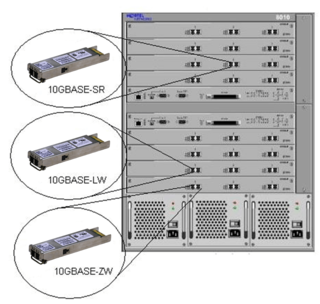
10 Gigabit Ethernet is a group of computer networking technologies for transmitting Ethernet frames at a rate of 10 gigabits per second. It was first defined by the IEEE 802.3ae-2002 standard. Unlike previous Ethernet standards, 10GbE defines only full-duplex point-to-point links which are generally connected by network switches; shared-medium CSMA/CD operation has not been carried over from the previous generations of Ethernet standards so half-duplex operation and repeater hubs do not exist in 10GbE. The first standard for faster 100 Gigabit Ethernet links was approved in 2010.
Terabit Ethernet (TbE) is Ethernet with speeds above 100 Gigabit Ethernet. The 400 Gigabit Ethernet and 200 Gigabit Ethernet standard developed by the IEEE P802.3bs Task Force using broadly similar technology to 100 Gigabit Ethernet was approved on December 6, 2017. On February 16, 2024 the 800 Gigabit Ethernet standard developed by the IEEE P802.3df Task Force was approved.
IEEE 802.3bz, NBASE-T and MGBASE-T are standards released in 2016 for Ethernet over twisted pair at speeds of 2.5 and 5 Gbit/s. These use the same cabling as the ubiquitous Gigabit Ethernet, yet offer higher speeds. The resulting standards are named 2.5GBASE-T and 5GBASE-T.
References
- ↑ IEEE Standards Association:802.3cg-2019 - IEEE Standard for Ethernet - Amendment 5:Physical Layer Specifications and Management Parameters for 10 Mb/s Operation and Associated Power Delivery over a Single Balanced Pair of Conductors available at
- ↑ "Ethernet - To the Field". Ethernet-apl White Paper. ethernet-apl. 2020. p. 18. Retrieved 2021-05-03.
- 1 2 "Explosive atmospheres - Part 47: Equipment protection by 2-Wire Intrinsically Safe Ethernet concept (2-WISE)". webstore.iec.ch. International Electrotechnical Commission. 2021-02-03. IEC TS 60079-47:2021. Retrieved 2022-02-16.